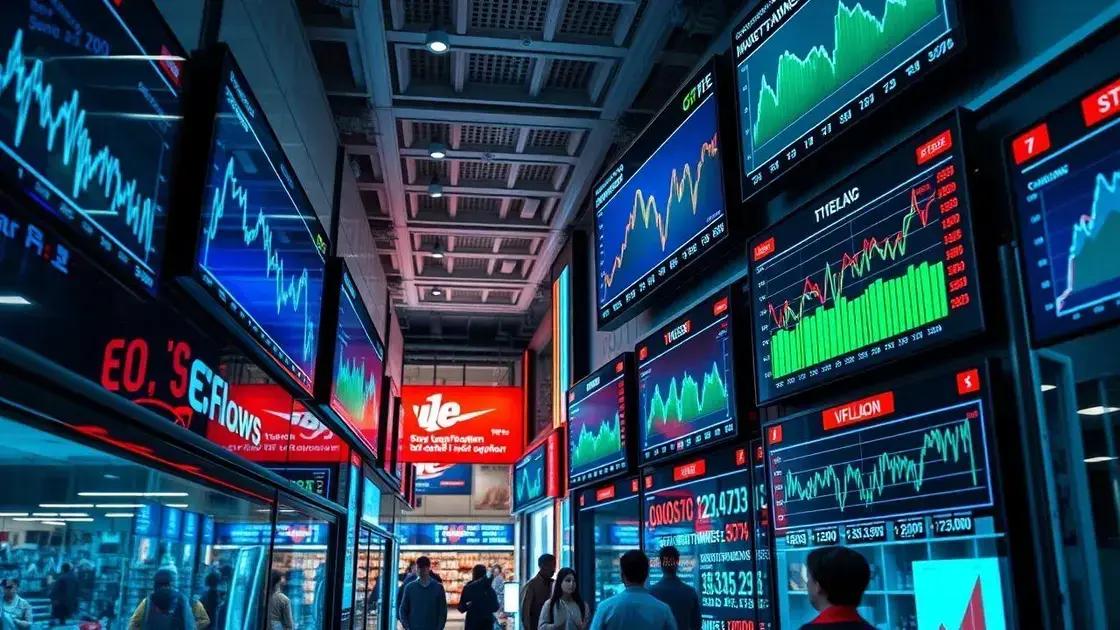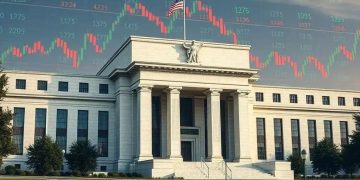Economic indicators that affect consumer behavior

Economic indicators that affect consumer behavior include inflation, unemployment rates, and consumer confidence, which determine spending habits and overall economic activity.
Economic indicators that affect consumer behavior play a vital role in shaping our buying decisions. Have you ever wondered how these factors influence your daily purchases? Let’s dive into the details.
Understanding economic indicators
Understanding economic indicators is crucial for anyone looking to grasp how the economy operates and influences our daily lives. These indicators provide valuable insights into trends and conditions that impact consumer behavior.
What Are Economic Indicators?
Economic indicators are statistics that reflect the economic health of a country. They can be categorized into different types based on their nature and function. By analyzing these indicators, businesses and consumers can make informed decisions.
- Leading indicators: These predict future economic activity, such as stock market performance.
- Coincident indicators: They occur in real-time, like employment data.
- Lagging indicators: These follow an event; for example, the unemployment rate reflects economic downturns.
As you can see, each type plays a unique role in understanding the overall economic picture. For instance, when interest rates change, it affects consumer spending and borrowing, which are directly linked to consumer behavior.
Why Do They Matter?
Being aware of these indicators can help consumers make better choices. When you understand that inflation is rising, for instance, you might decide to hold off on big purchases. Just like a weather forecast, they help you prepare for changes in the economy.
Many indicators are interconnected. A rise in unemployment rates can lead to decreased consumer confidence. When people are worried about their jobs, they’re less likely to spend money. This relationship illustrates how economic indicators directly affect our spending habits.
Monitoring these indicators helps in recognizing potential changes early. By staying informed, consumers can navigate through uncertainty more effectively. Understanding the signals from economic indicators enables you to adapt your personal finances and spending patterns for better outcomes.
How inflation impacts consumer spending

Inflation significantly affects consumer spending patterns. When prices rise, consumers often feel the pressure in their wallets. Understanding this relationship is essential for navigating financial choices.
What Is Inflation?
Inflation refers to the general increase in prices and the fall in the purchasing value of money. It means the same amount of money buys fewer goods and services over time. This drop in purchasing power influences how consumers make spending decisions.
- Rising prices: Consumers may prioritize essential items, reducing discretionary spending.
- Impact on savings: Higher inflation rates can discourage saving, as the money loses value.
- Consumer confidence: If people expect prices to keep rising, they may rush to buy now rather than later.
For example, when the price of basic needs like food and gas goes up, families have less to spend on entertainment or new clothing. This shift can lead to reduced business revenues in non-essential sectors. It’s a ripple effect where one change in the economy can significantly impact various sectors.
Strategies for Consumers
During periods of inflation, consumers can adopt specific strategies to manage their budgets wisely. Recognizing that inflation affects different goods differently can help consumers prioritize their spending. For instance, focusing on items that offer essential value can maintain quality of life.
Additionally, seeking alternatives, like buying generic brands or using store discounts, can mitigate the impact of rising prices. Consumers can also explore investment options that can outpace inflation, helping to preserve their purchasing power over time.
Overall, understanding how inflation influences consumer behavior allows individuals to adapt their strategies, ensuring they are prepared for changes in the market and can make informed decisions about their spending habits.
The role of unemployment rates
The role of unemployment rates is crucial in understanding how they influence consumer behavior. When unemployment rises, it often leads to significant changes in spending patterns.
Understanding Unemployment Rates
Unemployment rates measure the percentage of the labor force that is without work but actively seeking employment. This statistic provides insight into the economic health of a country. A high unemployment rate can indicate economic downturns and a lack of job opportunities.
- Impact on consumer confidence: High unemployment typically lowers consumer confidence. When people are uncertain about their job security, they tend to cut back on spending.
- Changes in purchasing power: With fewer people employed, overall purchasing power in the economy diminishes, affecting demand for goods and services.
- Spending on necessities: Consumers prioritize essential items during high unemployment, reducing discretionary purchases.
As the unemployment rate rises, the emotional and financial stability of consumers may decline significantly. This deterioration not only impacts individual families but also affects overall economic growth. Businesses may see lower sales figures due to decreased consumer spending.
Consumer Adaptations
Consumers react to increased unemployment rates by adjusting their spending habits. Many may shift their focus to value-oriented products. Seeking deals, using coupons, and opting for generic brands become common strategies. Additionally, consumers may place a greater emphasis on saving money in uncertain times, opting to postpone big purchases.
The ripple effects of unemployment extend beyond individual households. Local businesses face challenges if consumer spending decreases. This connection highlights how the unemployment rate is more than just a number; it directly shapes the economic landscape that we navigate daily.
Consumer confidence and its effects

Consumer confidence plays a vital role in the economy. It reflects how optimistic or pessimistic individuals feel about their financial situations, which directly impacts their spending behavior.
What Is Consumer Confidence?
Consumer confidence is a measure of how secure people feel about their financial future. When confidence is high, consumers are more likely to spend money, stimulating economic growth. Conversely, low consumer confidence can lead to reduced spending and a slowdown in economic activity.
- High consumer confidence: People tend to make large purchases like cars and homes.
- Low consumer confidence: Consumers are more likely to save money and cut back on non-essential spending.
- Impact on businesses: Strong confidence can lead to increased sales for businesses, while weak confidence can create economic challenges.
The connection between consumer confidence and economic performance is evident. For instance, when people feel optimistic about their job security and financial prospects, they tend to shop more freely. This behavior boosts sales and encourages businesses to hire more workers or invest in expansion.
Factors Influencing Consumer Confidence
Several factors impact consumer confidence. These include economic indicators such as unemployment rates and inflation. Political stability and major events, like natural disasters or health crises, also play a role. When there is uncertainty in any of these areas, consumer confidence can drop.
Additionally, media coverage of the economy can sway public perception. Positive news about job growth can uplift spirits, while reports of financial troubles can instill fear. Understanding these influences helps businesses and policymakers gauge potential outcomes in consumer spending.
Ultimately, consumer confidence is a crucial driver of economic activity. Keeping an eye on trends can help individuals and businesses make informed decisions during changing economic times.
FAQ – Frequently Asked Questions about Economic Indicators and Consumer Behavior
What are economic indicators?
Economic indicators are statistics that provide insights into the economic health of a country, influencing consumer behavior and spending.
How does inflation affect consumer spending?
Inflation raises prices, causing consumers to prioritize essential purchases and limit discretionary spending due to reduced purchasing power.
What is consumer confidence and why is it important?
Consumer confidence measures how optimistic people feel about their financial situation, influencing their willingness to spend money.
How do unemployment rates impact the economy?
High unemployment rates can lower consumer confidence and spending, which can lead to slower economic growth and reduced business revenues.





